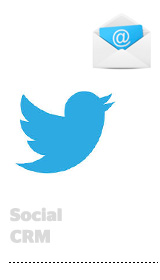 Twitter has opened up Lead Generation cards to all advertisers after a limited release earlier this May.
Twitter has opened up Lead Generation cards to all advertisers after a limited release earlier this May.
Twitter appears to be after direct-response advertising. Writing in a blog post, Twitter product manager Tarun Jain described the Lead Gen cards as “a streamlined tool to help advertisers find and connect off-Twitter with users interested in their message.”
“There is an enormous pile of marketing money beyond branding [on Twitter] when you get into driving significant business metrics,” noted Laura O’Shaughnessy, CEO of Twitter ads API partner SocialCode. “This essentially means you are either selling products or getting customers closer to the company… Twitter already has my email address and they are, basically, helping me so I don’t have to re-enter it.”
Based on feedback from early advertisers, Twitter has rolled out new functionality for lead generation, including direct uploads of incoming leads to CRM databases with the ability to format leads from Twitter ads into spreadsheets. Twitter’s also beefing up lead-gen analytics by introducing metrics like cost-per-lead by card. Using the Cards Manager, a marketer can stack one card against another to determine output in spend and subsequent leads derived.
As Twitter develops more methods to monetize its platform — including yesterday’s announced acquisition of social TV analytics company Trendrr and its hire of a head of commerce earlier this week — Lead Generation cards look like a push on Twitter’s part to maintain a relevant user experience despite its commercialization efforts.
“Lead Generation cards … provide both an incredibly easy end-user experience and verified emails for the marketer,” wrote Ellen Valentine, a product evangelist for marketing automation platform Silverpop, in a blog post. One early user, outdoor apparel retailer Rock/Creek, generated more than 1,700 new email leads in less than a week running a promotional offer with Lead Gen cards.
According to Andrew Foxwell, agency PPC Associates’ Director of Social, Twitter will not stop with this particular ad unit. “The more Twitter can keep people conversing and showing a brand a value of a consumer conversation, the better,” he noted. “This ad unit is a direct answer from Twitter on how they are going to solve the problem of not every advertiser having an ideal mobile experience.”
O’Shaughnessy added, “I think this will be central to the Twitter ads platforms and will go hand-in-hand with the retargeting capabilities they rolled out at the beginning of summer.” She called Facebook an “enormous and profitable direct-response channel” for brands and SocialCode clients. It “makes complete sense,” she said, for Twitter to hone its products to drive leads and sales in a similar fashion.












